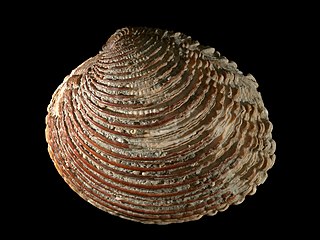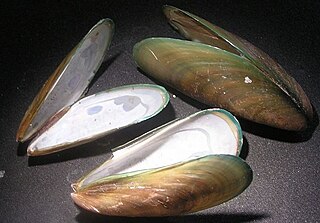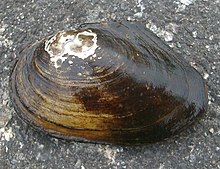
The order Ostreida includes the true oysters. One superfamily (Ostreoidea) and two extant families are recognised within it. The two families are Ostreidae, the true oysters, and Gryphaeidae, the foam oysters.

A cockle is an edible marine bivalve mollusc. Although many small edible bivalves are loosely called cockles, true cockles are species in the family Cardiidae.

The Arcida is an extant order of bivalve molluscs. This order dates back to the lower Ordovician period. They are distinguished from related groups, such as the mussels, by having a straight hinge to the shells, and the adductor muscles being of equal size. The duplivincular ligament, taxodont dentition, and a shell microstructure consisting of the outer crossed lamellar and inner complex crossed lamellar layers are defining characters of this order.

The Veneridae or venerids, common name: Venus clams, are a very large family of minute to large, saltwater clams, marine bivalve molluscs. Over 500 living species of venerid bivalves are known, most of which are edible, and many of which are exploited as food sources.

The Pteriida are an order of large and medium-sized marine bivalve mollusks. It includes five families, among them the Pteriidae.

The Pteriomorphia comprise a subclass of saltwater clams, marine bivalve molluscs. It contains several major orders, including the Arcida, Ostreida, Pectinida, Limida, Mytilida, and Pteriida. It also contains some extinct and probably basal families, such as the Evyanidae, Colpomyidae, Bakevelliidae, Cassianellidae, and Lithiotidae.

Trigonioidea is superfamily of medium-sized saltwater clams, marine bivalve molluscs. Within the fossil record the occurrence of this superfamily is widespread, ranging from the Devonian Period to Recent.

Nuculidae is a family of small saltwater clams in the order Nuculida. Species in this family are commonly known as nut clams.

Unionida is a monophyletic order of freshwater mussels, aquatic bivalve molluscs. The order includes most of the larger freshwater mussels, including the freshwater pearl mussels. The most common families are the Unionidae and the Margaritiferidae. All have in common a larval stage that is temporarily parasitic on fish, nacreous shells, high in organic matter, that may crack upon drying out, and siphons too short to permit the animal to live deeply buried in sediment.

Mytilida is an order of marine bivalve molluscs, commonly known as true mussels. There is one extant superfamily, the Mytiloidea, with a single extant family, the Mytilidae.

Anomalodesmata is an superorder of saltwater clams, marine bivalve molluscs. This grouping was formerly recognised as a taxonomic subclass. It is called a superorder in the current World Register of Marine Species, despite having no orders, to parallel it with sister taxon Imparidentia, which does have orders.

Isognomonidae is a family of medium-sized to large saltwater clams. They are pearl oysters, marine bivalve molluscs in the superfamily Pterioidea

Protobranchia is a subclass of bivalve molluscs. It contains the extant orders Nuculanida, Nuculida, and Solemyida.

Pectinida is a taxonomic order of large and medium-sized saltwater clams, marine bivalve molluscs, commonly known as scallops and their allies. It is believed that they began evolutionarily in the late Middle Ordovician epoch; many species, of course, are still extant.

Trigoniida is an order of medium-sized saltwater clams, marine bivalve molluscs. Within the fossil record the occurrence of this order is widespread, ranging from the Devonian Period to Recent.

In May 2010, a new taxonomy of the Bivalvia was published in the journal Malacologia. The 2010 taxonomy is known as the Taxonomy of the Bivalvia . The 2010 taxonomy was published as Nomenclator of Bivalve Families with a Classification of Bivalve Families. This was a revised system for classifying bivalve mollusks such as clams, oysters, scallops, mussels and so on. In compiling this new taxonomy, the authors used a variety of phylogenetic information including molecular analysis, anatomical analysis, shell morphology and shell microstructure, as well as bio-geographic, paleobiogeographical and stratigraphic information.
Lucinida is a taxonomic order of saltwater clams, marine bivalve molluscs.

Euheterodonta is an subterclass of Mollusca in the class Bivalvia.

Ambleminae is a subfamily of freshwater mussel in the family Unionidae. They are found throughout much of eastern North America south to Central America, although fossils are also known from Siberia. Some species have also been introduced to East Asia. They are the most speciose radiation of the Unionidae, with more than 300 species.
















